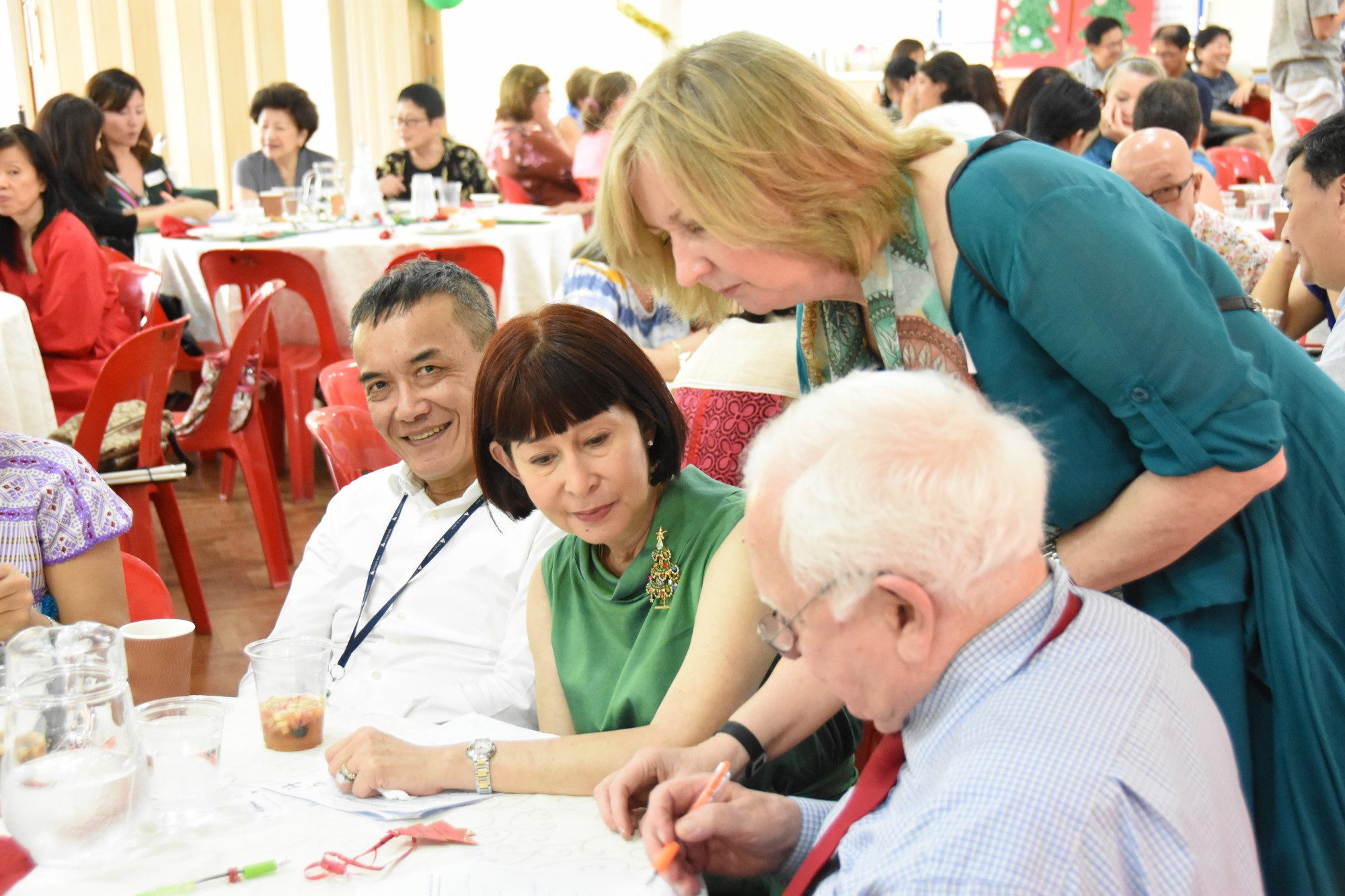About SGC

Along with all churches in the reformed Christian tradition, our faith is in the triune God as He is revealed in the Old and New Testament scriptures, and as is articulated in the Nicene Creed.
Our Mission
To present every person complete in Christ. Colossians 1:28
To glorify Christ by living and proclaiming His gospel in Singapore and beyond, and loving and caring for all in His name.
Our Vision
St .George’s Church is a growing, multicultural, Christ-
DECLARE –
PREPARE –
CARE –
Staff and Leadership
Clergy
Jonathan Wong
Acting Vicar
Paul Tan
Senior's Pastor
Pastoral Staff
Sean Tan
Life Groups & Courses
Priscilla Chua
Women and Families
Hydie Valdez
Toddler Time & Filipino
Admin Staff
Peter Khoo
Admin Manager
Annette Ho
Finance Executive
Betty Wu
Worship Secretary
Lesley Limpin
Administrative Executive
Cynthia Lamb
Property Secretary
Harold McIntyre
Verger
Isaac Johnson
Digital Strategist
Sharon Tan
Administrative Executive
PCC Members
The parochial church council (PCC) is the executive body of the St. George’s Church. A PCC consists of the clergy and Church Wardens of the parish, together with a number of representatives of the laity. They are elected at the Annual Parochial Church Meeting by means of being nominated and seconded at the meeting and also be listed on the parish roll.
At St. George’s Church, the PCC is responsible for the financial affairs of the church and the care and maintenance of the church fabric and its property.

Chris McPherson
Vicar's Warden

Yeo Siah Meng
People's Warden

John Tai
Honorary Treasurer

Choy Siew Kai
Synod Representative

Marc Wang
Synod Representative

Benjamin Ma
Honorary Secretary

Craig Martin
PCC Member

Erin Baker
PCC Member

Gerald Chan
PCC Member

Janey Torok-Lin
PCC Member

Marisa Bonel
PCC Member

Michael Kelly
PCC Member

Naomi Nixon
PCC Member

Priscilla Loke
PCC Member

Richard Hartung
PCC Member

Suzana Yeo
PCC Member
SGC’s History
St George’s Revisited
The following is a speech made by church member, David Jones, at a dinner held in 1996 to celebrate the 50th anniversary of the re-
‘When it was first suggested that I could give a talk on the history of St. George’s church for this celebration, I quickly realised that it would not be an easy task. While St. George’s is not a particularly old church, so much has happened to the church during its relatively short history, that it would be difficult to cover everything in a talk of 15 minutes.
The important point to state at the outset is that for the first 60 years of its existence this church was a military or garrison church of the British army. For the last 25 years it has been a civilian church… ‘
Major Malan’s Diary
Excerpts from the Diary of Major Malan (1868-
The following account combines excerpts from the diary of Major Malan, the first lay chaplain at St. George’s, and commentary from David Jones, a member of St. George’s congregation
The first desire
“From the time that God in His mercy led me to believe His Word, my whole heart was set on trying to glorify Him in the army. My desires were all to this end; and when our desires are in accordance with His will, we may leave them to Him to fulfil according to His infinite power and wisdom. Often when riding or walking alone, I had thought, ‘How I should like to be in command of a body of our men in some desolate island or solitary place, where there was nothing comfortable, and everything for the men’s comfort depended on me. How I should like to show them what a Christian commanding officer could do! I would let them see, by God’s grace, that a Christian can work as well as any other man.’ This desire had recurred again and again in my mind.
The island of Singapore was the place in which this desire was to be fulfilled. I found, on my arrival there, that the men of my regiment were in a state of the utmost discomfort. The barracks were only recently occupied, and had been built in the centre of a tropical jungle which swarmed with cobras, rats, frogs, and mosquitoes up to within a few feet of the very doors of their barrack-
Such was the state of things when I was put in command of the barracks. I saw the need of some earnest and decisive measures, but the obstacles appeared insurmountable. There was one resource for me. And that was prayer. I felt that I was responsible, alike to God and to my country, for the lives of these men; and that, unless something was done, many of them would perish by drink, and others would commit fearful crimes. I remembered Solomon’s prayer for wisdom, and I opened my Bible, and earnestly did I pray it: ‘Now, O Lord God, let Thy promise be established; for Thou hast made me. Give me now wisdom and knowledge that I may go out and come in before this people: for who can judge?’ (2 Chronicles 1: 9,10)
Clearing the way
The Tanglin Barracks, at Singapore, are situated on two high plateau, on one of which stands nine bungalows, the same size as those in the picture, and on the other, two more, forming the hospital. These large buildings, built to allow a free circulation of air between them, covered most of the available space. To clear the jungle all round them to a sufficient distance was no easy matter and the constant heavy tropical showers make growth of vegetation so rapid, that unless every shrub is not only cut down but rooted up, the jungle will grow again as strong as ever in a few months. There was another difficulty: the barracks were thatched, and there was great danger in burning the jungle within a few feet of those large roofs.
I rode round the barracks day by day after my arrival, thinking. I had prayed to God; and I felt it to be my duty, for my men’s sake, to work, leaving the results in His hands. The jungle must be cleared.
I wanted to make a short cut for those on duty between the main road and the guard and orderly rooms. This was begun by the defaulters –
The wonderful change which this clearing made in the appearance of the barracks –
I had the willing consent of the whole detachment –
Anyone for cricket?
I was one day going round the barracks on duty, not long after the first clearing was made, when I halted outside a barrack-
Within six months of that time the jungle was gone, and there, in its place, was a cricket-
The making of this cricket-
Fanning the flame
When the jungle was cleared, it had to be burned. On one occasion, after it was fired a breeze sprung up, and drove the flames down towards a little thatched building near the canteen. I saw the flames almost touching it, and high over it. If that building caught, the canteen would go too, and then, if the wind increased, the whole barracks!
I had ordered the bugler to sound the assembly, and then I prayed, ‘Lord, change the wind.’ Instantly –
After the ground had been levelled, the re was one thing more wanted for a good cricket-
Last of all there was the rolling of the ground. This was done by means of a large Government roller, which had been used with bullocks for the parade ground. My men soon got it on the cricket-
The cricket-
The men themselves took very great interest in their gardens. The once gloomy barracks were now brilliant with color.
The second desire
Yes there was so much more that God enabled His servant to do during his two and half year command in these barracks. His second desire was to be able to tell his men about the Lord Jesus Christ, who loved them and gave Himself for them.
There was no regular Military Chaplain, so every Sunday, as Commanding officer, it was his duty and great joy to read God’s word to his men and tell them of the love and power to save of the Lord Jesus Christ. They sang very heartily from the hymn book he had complied in 1863, finishing with prayer. After which was a hearty AMEN.
A Sunday School was started with the help of a schoolmaster –
All with one accord would recite –
A Bible class for married women was started and continued for more than a year, until eventually he was able to hand the meeting over to a dear friend who was in charge of the Chinese Girls School just off Orchard Road. She was able to visit these ladies in their homes.
It certainly wasn’t easy going –
He also had refreshing fellowship with many other Christians in Singapore, encouraging and being encouraged. Much more we could tell. But you will have to read it for yourselves.
But surely this was the start of the Christian Testimony at these Tanglin Barracks, under girded by prayer 120 years ago. From Jungle to Church? No, not a building but a Body of Christ on Earth.
Officers of the American, French, and Austrian navies, who came to call on us, were much struck by the appearance of the barracks, and could hardly believe that it had been done by them themselves assisted by some men with local skills
The second desire
My life is hid with Christ in God;
How safe, how blest am I!
For me to live ’tis therefore Christ
And therefore gain to die.
I would not change this blessed state,
The gift of freest grace,
For all the world could offer me,
Of glory, wealth or place.
I would not give the Christian’s hope
For everything on earth:
In Christ I am a son of God,
A king and priest by birth!
How great His love who honored thus
A sinful child of man!
Eternity will be too short
To tell Redemption’s plan.
O ye that have no hope in God,
Why do ye doubt His love?
His Son has bought you by His blood;
He pleads for you above.
Why do ye cast away the grace
To all who take it given?
Christ calls you,
‘Come thou, come to Me!
I’ll bring thee safe to heaven.’
Oh, come to Him, and you will find
In Him unceasing measure ?Of joy and peace!
His yoke is sweet,
His love life’s highest pleasure.
A soldier who committed his life to God and proved,
“There is nothing that God’s love and power cannot do – right here in Tanglin”
It was my joy to see during these two years the power of the Holy Spirit, as I had never seen it before among soldiers. If Satan worked –
What delight I had during those two years in the study of His Word! I often gave five hours a day to it. I commenced the first line of Genesis when I left England, and I went on over every line, annotating page by page. It was this that gave me strength for my work. Nothing but the thorough rest and refreshment which the soul of man gets in the quiet study of God’s Word could have sustained me in the severe physical labour I had at this station on the equator. Working hard as I did all six days, and still harder on the seventh, I should have been soon completely worn out, if it had not been for the continual renewal of strength which a man obtains in the study of God’s Word. He giveth power to the faint, and to those who have no might He increase the strength. I could not, perhaps, better express the state of joyful communion with the Lord in which I lived during these years, than in copying a few lines I wrote one morning before going down to the barracks on Duty. They flowed out of my heart faster than I could write them.
Architecture
The following is an extract from a talk given by church member and architect Richard Heald, at a dinner held to celebrate the 50th anniversary of the re-
“Architecture is about people and as we’ve heard tonight, St. George’s too is about people, and the people that have gone before us here. But the architecture is also about the three dimensional form of buildings –
A Closer Look
But perhaps what I like most about it are its many gentle subtleties. A lot of these, as with any friendship really, you only begin to realize after you’ve known the building for a while. For instance, I have tried to draw this church several times. I apologise for one of those attempts, which for some reason has been put on the front of the service books! Although as I say, it is a very simple, open and honest building, it is also very beautifully proportioned and very subtle in its line. So what appears to be a fairly simple thing to draw, turns out to be very tricky. It really is very difficult to get it right in a drawing –
Another aspect of course, and tonight is a great time to see this if you haven’t ever done so before, is the completely different character that the building assumes at night-
The Basilica Tradition
The style of the architecture, the form of this church, harks back many, many centuries to the very first specifically Christian churches of the Romanesque period in Europe –
The Christian basilica is basically a long rectangular barn, based on the already refined form of temple that the Greeks had perfected in ancient times and which the Romans had copied, a rectangle with a pitched roof and columns all round it. You came in at one end, where there are usually different doorways, and you faced the front. The action all happened up at the alter end, and whether you sat or wandered about, this was the basic format.
It was adapted over the centuries, got bigger and wider by various devices that I won’t bore you with now, and gained more and more elaborate features to add to their prominence within a city and to show off the Church’s ever increasing wealth and power. But the form has stayed very much the same and it is very functional. St. Paul’s Cathedral in London has this form, although you can hardly see it any more, and every little and great parish church in the world often has it too.
And as I said, St. George’s is a classic illustration of this. It is rather like a great big barn! It has the elegance and the feeling for function of a barn –
I love the building very much –
A Deliberate Design
It is built of brick and the bricks that you see are all that there is –
So there are “egg-
There are “dentil” moldings too, made out of the very shape of bricks themselves, just laying them in different ways. “Dentil” is from the Latin word for teeth –
There are other little slots too, with two bricks resting against each other, rather like when we build a house of cards. And there are what we call segment arches too –
The roof too is a simple and honest tied truss, all made from timber, apart from the thin little steel ties that pull them together and stop the huge weight of the tiled roof from pushing the walls outwards! It’s all there –
